Article by Laura Moldovan | Translation by Samuel Mago
Deutsch | Romanes | Rumänisch
The series „Romani Voices“ is giving people of the Roma community the opportunity to publish their opinions. The following text was written by Laura Moldovan. It is not a film review. It does not question the ability of Kusturica as a director. This text describes the perception of Laura Moldovan. It is her analysis of the „gypsies“ that Kusturica shows in his films and an analysis of what these constructed „gypsies“ and their caricatured world do with the perceptions of those who see these award-winning and highly acclaimed films.
The text is divided into 4 parts: an intro and 3 individual texts for different movies.
You are here: Part 1 Intro: Emir Kusturica and his „Gypsies“
Part 2: Opinion on „Time of the Gypsies“ (1989)
Part 3: Opinion on „Black cat, white cat“
Part 4: Opinion on „Blue Gipsy – All the invisible children“
More information and Emir Kusturica´s biographie here
Part 1: INTRO
Emir Kusturica and his “Gypsies “
by Laura Moldovan
He is probably the best-known filmmaker in the word of the Roma people. Hardly any name is as linked to the cinematography of the Roma as the name of this Gadjo. The admirers of his work are convinced that his movies are introducing them to the real life of the Roma. It almost feels as if they had spent their childhood with the main characters of “Black Cat, White Cat”. Even the Roma themselves seem to identify themselves with his movies.
Only at second glance the cat jumps out of the bag: The work of Emir Kusturica is merely the stereotypical representation of what is known by the majority of the people as “Gypsies”. And Antigypsyism becomes a box office bomb.
Black benefactor, white liar
Kusturica is a very intelligent person. He is consciously twisting the facts as he pleases:
„The Gypsies of my film survive like insects, according to the principle of the natural selection, according to the beauty of the colours and the shapes of the wings.„
he says in 1999 in an interview published in the German Novo Magazine, 1999. He is calling us „insects“ thereby using the rhetoric of the Nazis, but immediately continues to aestheticize the sentence with beautiful words. So – Gypsies are insects, parasites. But they are also beautiful insects, right?
In 2002, Emir Kusturica was named Goodwill-Ambassador by UNICEF. „I wanted to help the kids as much as I can“ he said in an interview with www.zmag.org. The fact that he is actually putting the future of the young Roma generation at stake with his films by portraying them as parasites of the lowest stratum of society obviously doesn’t matter.
“I was raised in a middle-class family close to the place where the Gypsies lived [in Sarajevo], and I was always enthusiastic about their freedom, the way they accepted life, their direct connection to joy, and their strength and optimism. Gypsies have a very bad position in society because every middle-class mother-fucker likes to have somebody beneath him. If you go to the district in Skopje in Macedonia where the Gypsies live, you’ll find a lot of people who hate them and who want nothing more than to be one step above them”
said Kusturica in an interview with Graham Fuller (1999).
The Time of Stereotypes
The so-called „freedom“ of the Roma is vehemently demanded in „Time of the Gypsies“ (1989) by a mad and stubborn protagonist right at the beginning of the film. The general feeling arises that the Roma are just not normal and submissive and do not want to integrate themselves into society.
The „direct connection to joy“ of the Roma is also portrayed in „Blue Gipsy“ (2005), as a manipulation tool using this „joie de vivre“ to pick people’s pockets. See Youtube Video:
The shown scene gives the public the impression that one should not be misled by „happy Roma“. Music, dance and joy – the only positive features attributed to the Roma – are shown negatively by Kusturica in this context.
„Black Cat, White Cat“ (1998) clearly shows that for Kusturica this „freedom“ and „joy of life“ means nothing but insolence and a primitive attitude towards life. Like in the scene in which a young man picks up his grandfather from the hospital alongside a marching band.
A popular theme in his work are Roma, who survive like insects. Despite this recurring image, Kusturica’s films are without a trace of the Roma genocide. We can see symbols for this in scenes such as the one from “Time of the Gypsies“, which shows a floating house.
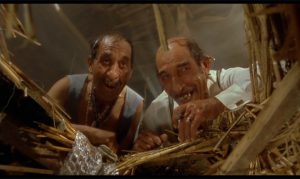
The two old men from „Black Cat, White Cat“, (Spoiler alert!) who rise from death at the end of the movie are also marked by this symbolism. This subject of survival is proposing a question to the audience:
„Why don’t they just die?“. However, replacing the question mark at the end of this question with the desire to wipe out the Roma.
Satire as a cover for racism
Kusturica uses the art of filmmaking to live out his personal racist ideas safely kept under the cover of satire. Every detail has a meaning and there is symbolism behind every punch line.
Because we have no state of our own, no political representation, and few instances working to protect the rights of the Roma, Kusturica allows himself to denigrate and vilify the Roma in his films.
There is a hidden hatred against Roma manifesting behind his rhetoric and the symbolism of his films, downright Antigypsyism.
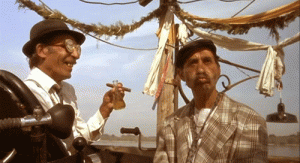
Kursturica’s work is generalizing. Negative characteristics and events – such as child trafficking, arranged marriages, forced marriages, begging, drugs, violence, theft, smuggling, corruption and gambling – are attributed to the Roma and made into their origin. Traditions and customs of the Roma on the other hand are mocked and exaggerated. The characters are not particularly attractive: we often see characters with golden teeth, hats and mustaches. Their clothes are cheesy and tasteless, their names are foreign and strange.
His main characters are often antagonists with human features. Even if they initially win the hearts of viewers with their „non-gypsy“ features, eventually it’s always pointed out that the exception only confirms the rule.
It is striking that the „gypsies“ in Kusturica’s films always live in isolation, in their own way, excluded from society. Contact with non-Roma is rare. If they do meet non-Roma, it is people who practice professions that are forbidden for the Roma in this made-up world: priests, mayors, doctors, nurses.
After all, if he had portrayed a Roma man integrated in society pursuing one of those professions, his image of a criminal, lazy and primitive people would not have been able to hold up cinematically.
From Idol to Idiot
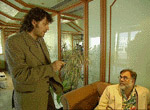
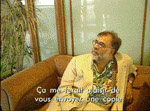
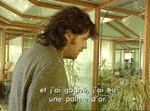
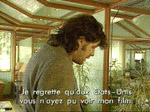
Kusturica meets Coppola | Source: kustu.com
Emir Kusturica was a big admirer of Francis Ford Coppola, which evidently shows in his work. At a personal meeting with the filmmaker at the Cannes Film Festival on May 11, 1997, Kusturica and Coppola finally met. Only then Kusturica realized that Coppola had never heard about him and his films. This obviously hurt him deeply, as this quote shows:
„I do everything not to become like Coppola,“
he stated afterwards in an interview with the French journal L’Evénement du Jeudi (2000). This statement tells a lot about Kusturica. He always overestimates his fame. „I’m not saying that I’m a genius, but …“ In any confrontation with the criticism, Kusturica is embarrassed and offended.
„He did not want to recognize me, I think. I was astonished that he had never heard about a single of my films „,
he says. Like this, even his former idol turns into an enemy because he does not receive the recognition and glory he attributes to himself.
„I’ve liked Coppola before. Today, Coppola does business. He has no time to be a director. He must be very unhappy. I’m recognized, which brings great advantages when you need to find funding for a new movie. I expose myself each minute of my life. I make the actor. I play music. Because I don’t want to be Coppola! With his fat belly, he couldn’t play rock.“,
he says in L’Evénement du Jeudi (2000).
Gypsy Whisperer
Kusturica’s work on Roma has received several awards. The work of a non-Roma who earned his money on the back of my people and abused the Roma for his own recognition and prestige. Regardless of his acquired wealth, it is painful and severe how he has built a successful career by defaming the Roma over time.
As the most popular international director for movies about Roma, he has laid the foundation for many of today’s prejudices. I am convinced that Kusturica’s films have significantly contributed to creating the negative image of our minority in the minds his viewers, and thus greatly increased xenophobia and Antigypsyism. Kusturica is a wanderer, just like the fictional fairytale-gypsies in his films.
„I am a man without a country, traveling between Paris and New York and Belgrade and Montenegro. My roots are in Herzegovina, but I don’t care about nationality. „,
he says in the interview with Graham Fuller. According to this logic, he should actually be empathetic towards his Gypsies, right?
Why does Emir Kusturica hate the Roma so much then? Maybe he has even answered this question himself:
„Because every middle-class motherfucker wants to have someone beneath him.“
Further artikels releated to Emir Kusturica:
You are here: Part 1 Intro: Emir Kusturica and his „Gypsies“
Part 2: Opinion on „Time of the Gypsies“ (1989)
Part 3: Opinion on „Black cat, white cat“
Part 4: Opinion on „Blue Gipsy – All the invisible children“
]]>
Deutsch | Romanes | Rumänisch
The series „Romani Voices“ is giving people of the Roma community the opportunity to publish their opinions. The following text was written by Laura Moldovan. It is not a film review. It does not question the ability of Kusturica as a director. This text describes the perception of Laura Moldovan. It is her analysis of the „gypsies“ that Kusturica shows in his films and an analysis of what these constructed „gypsies“ and their caricatured world do with the perceptions of those who see these award-winning and highly acclaimed films.
The text is divided into 4 parts: an intro and 3 individual texts for different movies.
Part 1 Intro: Emir Kusturica and his „Gypsies“
You are here: Part 2: Opinion on „Time of the Gypsies“ (1989)
Part 3: Opinion on „Black cat, white cat“
Part 4: Opinion on „Blue Gipsy – All the invisible children“
Part 2: Opinion on „Time of the Gypsies“ (1989)
by Laura Moldovan
For generations now Roma activists and Roma who are politically active, have stated that the time has come for us take back our rights and stand up against injustice. For someone who has not seen Emir Kusturica’s piece „Time of the Gypsies“, the title might just as well address this emancipation of the Roma. Until one has to admit as a viewer, that „Time of the Gypsies“ should rather have been called „Time of the anti-gypsies“.
About „Time of the Gypsies“ Emir Kusturica said in 1989:
„Why the gypsies? The only reason is that I was shocked that you could sell children.“
Although human trafficking is a socio-political issue that affects not only Roma, but also many other groups of people worldwide, Kusturica diminishes the Roma in his film to this subject matter.
Kusturica decides after his research to represent the Roma in the film as the mafia. At the same time, he is selling this decision as an open-mined choice that enables him to depicture and to become acquired with a different, a foreign culture for the first time:
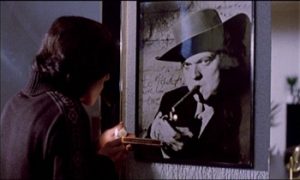
„Time of the Gypsies was my first step out of my garden – towards a different culture than my own. I started to learn how to look at another society „,
he explains in an interview with the French magazine „Le Monde“ January 23, 1993.
Kusturica conceals the fact that Roma have been actively involved in shaping the Balkan culture for centuries. According to him this minority in Europe is foreign and exotic.
Following the release of the film “Guardian Angel” (1987) by Goran Paskaljevic, Kusturica came across a newspaper article about a case of child trafficking, in witch rumors circulated that the perpetrators were members of the ethnic group of the Roma. As part of his research Kusturica spoke with the authors of the article, journalists and spent a lot of time in a Roma community in Macedonia.
Since the Roma in his work are always referred to as „gypsies“ it is probably a sign that Kusturica has only poorly researched the history of our people.
From the beginning, he is focusing exclusively on the representation of negative aspects of our life reality and always ready to embellish and inflate it.
Magical, mafia, godless and homeless
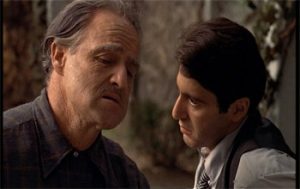
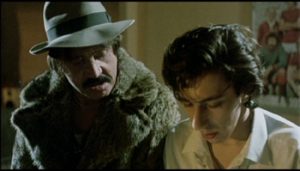
At times, the movie „Time of the Gypsies“ even looks like a remake of the Godfather I & II. Kusturica has obviously got some ideas off Francis Ford Coppola.
Apart from the external similarity of the protagonists Perhan and Michael Corleone, as well as Ahmed and Vito Corleone, it also covers the same subjects as Coppola’s Mafia epos: The question of the successor of the godfather and of course the rise and fall of a family, a mafia clan.
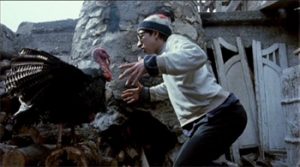
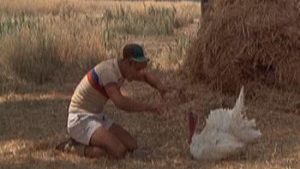
For „Time of the Gypsies“ Kusturica apparently also got inspired by the film „Amarcord“ by Federico Fellini. Themes such as weddings and banquets in nature, a crazy storyteller at the beginning of the film, the accordion and even a scene with turkey-hypnosis are reminiscent of Fellini’s circus world.
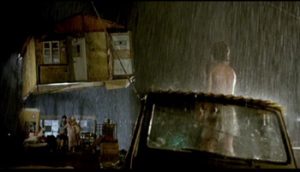
The film is based on an extremely racist world view represented through various motives: The original title of the film („Dom za vešanje“) in English basically means „The house to hang „. A scene in the movie is particularly fitting for the title, symbolizing that Roma have no real homes, no homeland and place in the world. This scene also stands for the steady „survival of the Roma“, who are still there even if others blow up or destroy their homes. For sales and marketing purposes the film title was changed abroad to „Time of the Gypsies“.
Weddings are a recurring theme in all of Kusturica’s films, including this one. Already the opening scene of the film shows a Romni in a wedding dress insulting her completely drunk husband and accusing him of having destroyed her life. This scene is repeated at the end in a different constellation.
Kusturica implies that Roma are miserable and bad husbands and not only destroy their own lives, but also the lives of their wives.
The main reason behind the behavior of all acting characters is being explained at the beginning of the film (see YouTube clip) by an obviously insane protagonist. He complains that he has been deprived of his freedom, had his wings and soul. Again, this imposes restlessness and homelessness on the Roma. My interpretation is that Kusturica wants to imply that the Roma do not want to integrate themselves but rather stubbornly insist on their alleged freedom in order to maintain their „own way of life“, even if this is disturbing to other people and causes them discomfort.
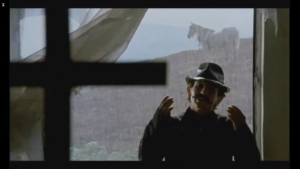
Another theme that shapes the film is religion combined with mysticism and magic. Also at the beginning of the film a legend about God and the Roma is introduced to the story. The legend tells how God came down to earth and left again because he could not stand the Roma. Thus, the Roma would ultimately be responsible for their unfortunate life situation, since they have even chased away the Lord himself. This legend does not exist within the Roma community, it is Kusturica’s invention. His psychological motivation behind it is questionable. Maybe he, like many directors, suffers from a God complex? Maybe he wanted to add even more magic and mystique to the film in order to reinforce the stereotypes?

Kusturica himself stated in an interview with the French journal L’Express (1989) that magic belongs to the life of the Roma. Therefore, he had given the character Perhan telekinetic abilities and equipped his grandmother with healing powers in the movie. The motif of the deterred God and the wedding, also returns at the end and creates a frame around the whole action: In the last scene of the film, a Roma prays to a fallen crucifix, which he picks up from the ground and hangs back on the wall. But when he tries to negotiate with God, the cross falls to the ground again.
Time of the geese
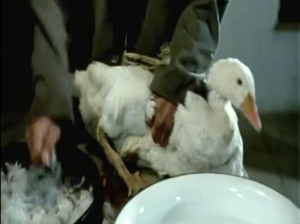
Kusturica explained in an interview his reference to geese in his films. He had heard a legend that highly fascinated him, according to which geese would have brought the „Gypsies“ from India to Europe two thousand years ago. In gratitude, the Roma cut off the geese’s wings. The symbolism of the truncated wings appears again and again in Kusturica’s work and represents the loss of freedom. In fact, Roma left the Indian subcontinent about a thousand years ago – most likely without the help of geese.
For Kusturica, legends sound better than reality. Through them he can live out his racist ways of thinking and artistically strengthen Antigypsyism in our society.
If we want to believe Kusturica’s films, the Roma are destroying their lives single-handedly. They are not Europeans, but ever foreign people who must be endured by the native Europeans. After his box office hit “Time of the Gypsies“ Kusturica brought his movie as a punk opera on the stages of Paris in 2007, musically accompanied by his band, the „No Smoking Orchestra“.
The gypsies of Emir Kusturica lost their feathers a long time ago. Whether Emir Kusturica should lose his pen also, is an open question.
Further artikels releated to Emir Kusturica:
Part 1 Intro: Emir Kusturica and his „Gypsies“
You are here: Part 2: Opinion on „Time of the Gypsies“ (1989)
Part 3: Opinion on „Black cat, white cat“
Part 4: Opinion on „Blue Gipsy – All the invisible children“
Deutsch | Romanes | Rumänisch
The series „Romani Voices“ is giving people of the Roma community the opportunity to publish their opinions. The following text was written by Laura Moldovan. It is not a film review. It does not question the ability of Kusturica as a director. This text describes the perception of Laura Moldovan. It is her analysis of the „gypsies“ that Kusturica shows in his films and an analysis of what these constructed „gypsies“ and their caricatured world do with the perceptions of those who see these award-winning and highly acclaimed films.
The text is divided into 4 parts: an intro and 3 individual texts for different movies.
Part 1 Intro: Emir Kusturica and his „Gypsies“
Part 2: Opinion on „Time of the Gypsies“ (1989)
You are here: Part 3: Opinion on „Black cat, white cat“
Part 4: Opinion on „Blue Gipsy – All the invisible children“
Part 3 | „Black Cat, White Cat“ (1998)
by Laura Moldovan
After winning the Cannes award for “Best Director” for “Time of the Gypsies”, Emir Kusturica starts shooting “Arizona Dream” in New York. He was able to win over well-known actors such as Johnny Depp and Jerry Lewis for this production. This is the beginning of a difficult time in the biography of Kusturica.
The work on Arizona Dream strikes him hard – his father dies and his homeland Yugoslavia falls apart in the war. After the death of his father, Kusturica returns to ex-Yugoslavia and shoots his most courageous film „Underground“, in which he critically reflects on the history of his homeland in the last 50 years. „I’m not trying to say that I’m a genius, but “Underground” was the strongest attack on Milosevic,“ Kusturica said in an interview with The Guardian in 1999.
At this point in his career, Kusturica actually wanted to stop making films. He felt as he had fulfilled his „duty“ and sensed strong political pressure. Afterwards began the work on the film „Black cat, white cat”. Due to his negative experiences with the movie „Underground“, Emir Kusturica reconsiders his thematic (critical) orientation and his style and decides to change the tone of voice, to cover more shallow themes and fade his films away into „happy endings“.
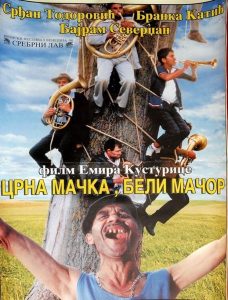
The original title of the movie „Black Cat, White Cat“ was „Acrobatic Music“. A scene that makes it easy to understand how this working title came about is the one showing a group of musicians tied to a tree as if it were the most normal thing in the world. This implies that the craziest things and situations are common in the life of the Roma. Kusturica allows himself to let his imagination run wild in this film and to come up with the most ridiculous and strange hypotheses about Roma and their culture.
The central topic of the film are weddings that take place despite of deaths in the family. The „happy ending“ comes with the resurrection of the old men – symbolizing the „survival of the Roma“ – and the victory of love. The main characters, Zare and Ida, are the only „normal“ people portrayed in the movie. On the cruise ship, they are relieved as they leave their relatives behind, illustrating Kusturica’s idea that only outside of the Roma community one can live a normal life.
„Happy ending“ | See YouTube Clip from Min 03:30
Strange, obscure and animally primitive
In Kusturica’s film, numerous bizarre characters appear: A bearded woman, an overweight mermaid, a green-haired bodyguard, the black obelisk, an overweight diva who can draw nails out of wood with her butt and countless others. Also, the magic can’t be missing from this movie. Due to a ritual made by the old one Zarije, he is only dead for one day in order to stop his nephew’s wedding. The grandson Zare also knows some magic tricks.
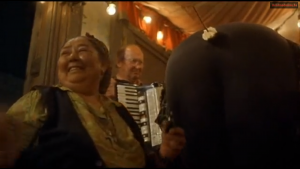
The fact that Kusturica is an admirer of Federico Fellini is also reflected in this film: he combines the daily life of the Roma with the circus and by that acquires the nickname „Fellini of the Balkans“. „I am proud to have discovered how this guy makes his films and that I can make mine in the same way. I use these little tricks, like a magician who sees a circus and goes to work in another. „(September 1999)
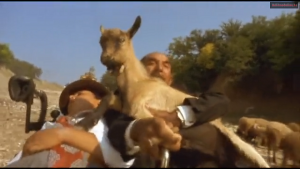
From the total chaos of this film – a circus in which the Roma coexist with animals – we conclude that Kusturica wanted to imply the similarity of the Roma to animals and their identification with them. In almost every scene in the film, animals are shown: dogs, goats, a peacock as a pet, cats as witnesses of a wedding, a pig eating a Trabant. Especially the geese can’t be missing as a recurring motif in Kusturica’s work. They are everywhere – in the yard, on the street, in the restaurant and even in the house. At the end of the film, they are even used instead of towels. Hereby Kusturica reminds of his favorite tale about Roma and geese.
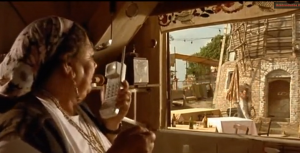
Kusturica wants to show the primitiveness of the Roma.
„They are medieval, but they have cellphones“,
he explains in an interview with the British newspaper The Guardian in 1999.
If it were for Emir Kusturica, we would probably still have to live in a golden cage for another hundred years, isolated from any technology. Like in the zoo, his audience could make fun of our suffering and our lives, just like in the circus.
A racist classic that makes it easy for the audience to put Roma into a convenient drawer of stereotypes only to take them out whenever they are needed.
Further artikels releated to Emir Kusturica:
Part 1 Intro: Emir Kusturica and his „Gypsies“
Part 2: Opinion on „Time of the Gypsies“ (1989)
You are here: Part 3: Opinion on „Black cat, white cat“
Part 4: Opinion on „Blue Gipsy – All the invisible children“
]]>
Deutsch | Romanes | Rumänisch
The series „Romani Voices“ is giving people of the Roma community the opportunity to publish their opinions. The following text was written by Laura Moldovan. It is not a film review. It does not question the ability of Kusturica as a director. This text describes the perception of Laura Moldovan. It is her analysis of the „gypsies“ that Kusturica shows in his films and an analysis of what these constructed „gypsies“ and their caricatured world do with the perceptions of those who see these award-winning and highly acclaimed films.
The text is divided into 4 parts: an intro and 3 individual texts for different movies.
Part 1 Intro: Emir Kusturica and his „Gypsies“
Part 2: Opinion on „Time of the Gypsies“ (1989)
Part 3: Opinion on „Black cat, white cat“
You are here: Part 4: Opinion on „Blue Gipsy – All the invisible children“
Part 4: „Blue Gipsy – All the invisible children” (2006)
by Laura Moldovan
The film „All the invisible children“ was produced as part of a UNICEF project and consists of a total of 7 short films by 8 directors. The film was released in 2006. Kusturica contributed to this project as one of these 8 directors with his short film „Blue Gipsy.
About his work on this short film, the filmmaker Kusturica says:
„I have expressed my observations, my obsessions. Someone gave me a key that I turned into a script. „
The title „Blue Gipsy“ refers to Roma with blue eyes, this is seen as a symbol for something good, something extraordinary.
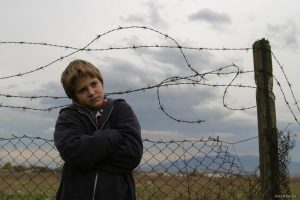
The main character Uros has spent a long time in a juvenile detention center. He has mixed feelings about his own release. He does not know what the future will bring if he has to live with his father again, who beats him and forces him to steal. Back in freedom, Uros is almost caught stealing. His flight from the crime ends up in juvenile prison again. An act he chooses consciously. The psychological level of this story is remarkable. It is implied that even in juvenile prison, Uros would have a better chance of getting himself and his life under control than within his joint family. In addition, throughout the whole movie it is suggested that Uros fate is already sealed: He belongs in prison, that is his place.
Generally, the Roma in this film are portrayed as thieves and deceivers, as bad and violent parents who keep their children uneducated. Another scene showing this is the one at the train station: a big begging Roma family is doing a show, playing music, singing and dancing. In the meantime, the enthusiastic audience gets robbed. With this Kusturica wants to imply that Roma abuse their music and „joie de vivre“ to deceive and exploit people (see YouTube video). The film suggests that it would be in everyone’s interest for them to live secluded and isolated from the outside world and mainstream society.
Movies like these are a big contributing factor to Roma being generally seen as inferior, parasitic people who have no place in society, which they neither seek nor want or can ever find. For the audience, negative prejudices against this ethnic group are confirmed and reinforced, and stereotypes about crime, caginess and violence are reproduced. Kusturica conveys that the Roma themselves are to blame for their unfortunate lives and that the poor living conditions that many Roma endure are not the result of centuries of discrimination, but due to the lack of understanding the European society and the failure of members of the minority.
A classic anti-gypsy film, which probably would have found the same kind of approval in the 1930s, as does today.
Further artikels releated to Emir Kusturica:
Part 1 Intro: Emir Kusturica and his „Gypsies“
Part 2: Opinion on „Time of the Gypsies“ (1989)
Part 3: Opinion on „Black cat, white cat“
You are here: Part 4: Opinion on „Blue Gipsy – All the invisible children“
]]>
Deutsch | Romanes | Englisch
Seria „Romani Voices“ dă posibilitate persoanelor din comunitatea romă să își publice părerea. Textul următor aparține Laurei Moldovan. Următorul text nu este o critică de film, iar abilitățile de regizor ale lui Emir Kusturica nu sunt puse sub semnul întrebării. Acest text descrie percepția Laurei Moldovan. Este analiza „Țiganilor“ prezentați de către Kusturica în filmele sale şi o analiză asupra felului în care acești „Țigani construiți’’ și lumea lor caricaturală influențează percepția celor care privesc aceste foarte cunoscute și premiate filme.
Textul are 4 părți: un Intro si 3 texte despre diferite filme.
Partea 1 Intro: „Emir Kusturica si Țiganii lui“ –> Partea 1 Versiunea Audio
Partea a 2-a: Perspectivă asupra filmului „Vremea țiganilor“ (1989)–> Partea 2 Versiunea Audio
Partea a 3-a: Perspectivă asupra filmului „Pisica albă, pisica neagră“ (1998)–> Partea 3 Versiunea Audio
Sunteți aici: Partea a 4-a: Perspectivă asupra filmului „Blue Gipsy – All the invisible children“ (2005)–> Partea 4 Versiunea Audio
Sau ascultă varianta întreagă a articolului –> Partea 1-4
Partea a 4-a: Perspectivă asupra filmului „Blue Gipsy – All the invisible children“ (2005)
de Laura Moldovan
Filmul „All the invisible children“ a fost produs în cadrul unui proiect UNICEF și cuprinde în total 7 filme de scurt metraj realizate de către 8 regizori. Filmul a fost lansat în 2006, Kusturica contribuind la acest proiect ca şi unul dintre cei 8 regizori- cu filmul său „Blue Gipsy“.
Referitor la acest film, regizorul Kusturica spune:
„Mi-am exprimat observațiile și obsesiile mele. Cineva mi-a dat o cheie, pe care am transformat-o într-un scenariu„.
Titlul „Blue Gipsy “ se referă la romii cu ochi albaștri, acest lucru fiind văzut ca un simbol al binelui și al „ieșitului din comun”.

Personajul principal cu ochi albaștrii, Uros, a petrecut mult timp în centrul de detenție pentru minori. El are sentimente amestecate cu privire la propria sa eliberare şi nu știe ce va aduce viitorul, când va trebui să trăiască din nou cu tatăl său, care îl bate și îl obligă să fure. Înapoi în libertate, Uros este aproape prins furând. Evadarea lui se termină din nou în centrul de detenție pentru minori, un act ales în mod conștient. Nivelul psihologic al acestei povești este frapant. Se insinuează că, până și în centrul de detenție pentru minori, Uros ar avea posibilități mai bune de a-și controla viața, decât în unitate cu familia sa. În plus, este sugerat pe tot parcursul filmului că soarta lui Uros este deja pecetluită- el face parte din centrul de detenție, aici este locul lui.
În general, romii sunt portretizați în film ca şi infractori si escroci, ca şi părinți răi și violenți, care nu își educă copiii în mod corect. O altă scenă în care acest lucru se face vizibil este cea de la gară: o familie mare de romi cerșetori fac un mic spectacol, cântă și dansează. Între timp, audiența entuziastă este jefuită. Prin această scenă, Kusturica vrea să insinueze că, romii abuzează de muzică și de „bucuria de a trăi“ , pentru a înșela și a exploata oamenii (priviti clipul youtube). Filmul sugerează, că ar fi mai bine pentru toată lumea, ca romii să trăiască izolați de lumea exterioară și de societatea majoritară.
Filmele ca acestea sunt un factor important, care contribuie la imaginea generală a romilor ca persoane inferioare, parazitare, care nu au, nu caută, nu doresc și nu pot găsi niciodată un loc în societate. Pentru public, prejudecățile negative asupra acestui grup etnic sunt confirmate și întărite, iar stereotipurile cu privire la criminalitate, izolare și violență sunt reproduse. Kusturica transmite faptul că romii înșişi ar fi vinovați pentru viața lor precară, și condiția săracă în care mulți trebuie să trăiască, nu a apărut din cauza secolelor întregi de discriminare, ci din cauza lipsei de înțelegere cu societatea europeană și a eșecului membrilor minorității.
Acesta este un film clasic anti-țiganistic, care ar fi găsit şi în anii 1930 aceeași aprobare ca și astăzi.
Alte articole despre Emir Kusturica:
Partea 1 Intro: „Emir Kusturica si Țiganii lui“ –> Partea 1 Versiunea Audio
Partea a 2-a: Perspectivă asupra filmului „Vremea țiganilor“ (1989)–> Partea 2 Versiunea Audio
Partea a 3-a: Perspectivă asupra filmului „Pisica albă, pisica neagră“ (1998)–> Partea 3 Versiunea Audio
Sunteți aici: Partea a 4-a: Perspectivă asupra filmului „Blue Gipsy – All the invisible children“ (2005)–> Partea 4 Versiunea Audio
Sau ascultă varianta întreagă a articolului –> Partea 1-4
]]>
Deutsch | Romanes | Englisch
Seria „Romani Voices“ dă posibilitate persoanelor din comunitatea romă să își publice părerea. Textul următor aparține Laurei Moldovan. Următorul text nu este o critică de film, iar abilitățile de regizor ale lui Emir Kusturica nu sunt puse sub semnul întrebării. Acest text descrie percepția Laurei Moldovan. Este analiza „Țiganilor“ prezentați de către Kusturica în filmele sale şi o analiză asupra felului în care acești „Țigani construiți’’ și lumea lor caricaturală influențează percepția celor care privesc aceste foarte cunoscute și premiate filme.
Textul are 4 părți: un Intro si 3 texte despre diferite filme.
Partea 1 Intro: „Emir Kusturica si Țiganii lui“ –> Partea 1 Versiunea Audio
Partea a 2-a: Perspectivă asupra filmului „Vremea țiganilor“ (1989)–> Partea 2 Versiunea Audio
Sunteți aici: Partea a 3-a: Perspectivă asupra filmului „Pisica albă, pisica neagră“ (1998)–> Partea 3 Versiunea Audio
Partea a 4-a: Perspectivă asupra filmului „Blue Gipsy – All the invisible children“ (2005)–> Partea 4 Versiunea Audio
Sau ascultă varianta întreagă a articolului –> Partea 1-4
Partea a 3-a: Perspectivă asupra filmului „Black Cat, White Cat“ (1998)
de Laura Moldovan
După ce a câștigat premiul Cannes- de cel mai bun regizor pentru filmul „Time of the Gypsys”, Emir Kusturica începe să filmeze ,, Arizona Dream’’, în New York. Pentru aceasta producţie, câștigă actori cunoscuți cum ar fi Johnny Depp și Jerry Lewis. Aici începe o perioadă dificilă în biografia lui Kusturica.
Lucrările la ,,Arizona Dream’’ îi sunt îngreunate – tatăl său moare și patria sa, Iugoslavia, se destramă în război. După moartea tatălui său, Kusturica revine în fosta Iugoslavie și face cel mai curajos film al său, „Underground“, în care reflectă în mod critic istoria ultimilor 50 de ani ai patriei sale. „Nu încerc să spun că sunt un geniu, dar „Underground“ a fost cel mai puternic atac asupra lui Milosevic„, a spus Kusturica într-un interviu acordat la The Guardian, în 1999.
În acest moment al carierei sale, Kusturica a vrut de fapt să înceteze să mai facă filme. El a simțit că și-a îndeplinit „datoria“, dar a simțit și o puternică presiune politică. „Mi-am dat seama că ar fi sinucidere, să nu mai fac filme„, a explicat el la conferinta de presa de la Montreal, in anul 2000. Astfel, au început lucrările pentru filmul „Black Cat, White Cat“. Emir Kusturica regândește tematica și stilul și decide să schimbe tonul pentru a trata subiecte mai ușoare și sa-și incheie filmele cu „Happy End“.

Titlul original al filmului „Black Cat, White Cat“ a fost „Acrobatic Music“. O scenă care clarifică repede cum s-a ajuns la acest titlu este şi-o scenă cheie a filmului: un grup de muzicanți cântând, agățați fiind de un copac, ca și cum ar fi fost cel mai normal lucru din lume. Acest lucru implică faptul că pentru romi, cele mai nebunești lucruri și situații înseamnă normalitate. Kusturica își permite să dea frâu liber imaginației și să stabilească cele mai ciudate si ridicole ipoteze despre romi și despre cultura lor.
Tema centrală a filmului se constituie din nunțile care se țin în pofida deceselor din familie. „Happy end“-ul vine cu învierea bătrânilor – simbolizând „supraviețuirea romilor“ – și cu victoria iubirii. Personajele principale, Zare și Ida, singurii oameni „normali“ din film, își iau rămas bun fericiți de la rudele lor și pleacă pe un vas de croazieră, pentru a confirma ideea că doar în afara comunității rome se poate duce o viață normală. „Happy End“ | Priviti clipul YouTube de la Min 03:30
Ciudat, obscur, animalic și primitiv
În filmul lui Kusturica, apar numeroase personaje bizare: o femeie cu barbă, o sirenă obeză, un bodyguard cu păr verde, Obeliscul Negru – o divă supraponderală, care scoate cuie din lemn cu fundul, etc. Nici magia nu trebuie să lipsească din film. Ea este prezentă prin incantația bătrânului Zarije care, pentru a opri nunta nepotului său, îşi provoacă moartea temporară. Chiar și nepotul Zare cunoaște câteva trucuri magice.

Faptul că Emir Kusturica este un admirator al lui Federico Fellini se vede și în acest film: el leagă traiul cotidian al romilor cu circul și îşi dezvoltă astfel porecla „Fellini dinBalcani“. „Sunt mândru că am descoperit cum își face filmele acest tip și că pot să le fac și eu pe ale mele în aceelași mod. Folosesc aceste mici trucuri ca şi-un magician, care vede un circ și merge să lucreze în altul„ (septembrie 1999).

Din haosul total al filmului – un circ în care romii coexistă cu animalele – trag concluzia că Emir Kusturica a vrut să insinueze similitudinea romilor cu animalele și identificarea lor cu aceștea. În aproape toate scenele din film, apar animale: câini, capre, un păun ca animal de companie, pisici ca martori de cununie, un porc care mănâncă un Trabant. Ca și motiv recurent, nici gâștele nu pot lipsi din operele lui Kusturica. Ele sunt peste tot – în curte, pe stradă, în restaurant și chiar şi-n casă. La sfârșitul filmului, acestea sunt chiar folosite pe post de prosoape. Astfel, amintește Kusturica de legenda sa favorită despre romi și gâște.

Kusturica vrea să arate primitivitatea romilor.
„Ei sunt medievali, dar au telefoane mobile“,
spune el într-un interviu în ziarul britanic „The Guardian“, în 1999.
Dacă ar fi după Emir Kusturica, le-ar trebui romilor, probabil, încă o sută de ani să trăiască stârpiți de orice tehnologie, într-o cușcă de aur. Ca și în grădina zoologică, publicul său ar putea să se distreze pe seama suferinței și vieților noastre, la fel ca şi la circ. Un film anti-țiganist clasic, care sugerează publicului să pună romii într-un sertar pentru a-i scoate ori de câte ori au nevoie.
Alte articole despre Emir Kusturicas :
Partea 1 Intro: „Emir Kusturica si Țiganii lui“ –> Partea 1 Versiunea Audio
Partea a 2-a: Perspectivă asupra filmului „Vremea țiganilor“ (1989)–> Partea 2 Versiunea Audio
Sunteți aici: Partea a 3-a: Perspectivă asupra filmului „Pisica albă, pisica neagră“ (1998)–> Partea 3 Versiunea Audio
Partea a 4-a: Perspectivă asupra filmului „Blue Gipsy – All the invisible children“ (2005)–> Partea 4 Versiunea Audio
Sau ascultă varianta întreagă a articolului –> Partea 1-4
]]>
Deutsch | Romanes | Englisch
Seria „Romani Voices“ dă posibilitate persoanelor din comunitatea romă să își publice părerea. Textul următor aparține Laurei Moldovan. Următorul text nu este o critică de film, iar abilitățile de regizor ale lui Emir Kusturica nu sunt puse sub semnul întrebării. Acest text descrie percepția Laurei Moldovan. Este analiza „Țiganilor“ prezentați de către Kusturica în filmele sale şi o analiză asupra felului în care acești „Țigani construiți’’ și lumea lor caricaturală influențează percepția celor care privesc aceste foarte cunoscute și premiate filme.
Textul are 4 părți: un Intro si 3 texte despre diferite filme.
Partea 1 Intro: „Emir Kusturica si Țiganii lui“ –> Partea 1 Versiunea Audio
Sunteți aici: Partea a 2-a: Perspectivă asupra filmului „Vremea țiganilor“ (1989)–> Partea 2 Versiunea Audio
Partea a 3-a: Perspectivă asupra filmului „Pisica albă, pisica neagră“ (1998)–> Partea 3 Versiunea Audio
Partea a 4-a: Perspectivă asupra filmului „Blue Gipsy – All the invisible children“ (2005)–> Partea 4 Versiunea Audio
Sau ascultă varianta întreagă a articolului –> Partea 1-4
Partea a 2-a: Perspectivă asupra filmului „Time of the Gipsys“ (1989)
de către Laura Moldovan
De-a lungul generațiilor, activiștii romi și romii angajati politic au vorbit despre faptul că a venit timpul să ne luăm drepturile și să ne opunem nedreptății. Pentru cineva care nu a vizionat lucrarea lui Emir Kusturica (biografie) „Time of the Gipsys“, titlul ar putea trata bine această emancipare a romilor. Dar, ca spectator, trebuie admis faptul că „Time of the Gipsys“, ar fi trebuit să fie numit mai degrabă „Time of the anti-tziganists“.
Despre „Time of the Gipsys“, Emir Kusturica a spus- în 1989:
„De ce țiganii? Singurul motiv este că am fost șocat, că s-ar putea vinde copii„.
Cu toate că traficul de ființe umane este o problemă de politică socială, care nu se referă numai la romi, ci la multe alte grupuri de oameni din întreaga lume, Kusturica reduce romii pe acest subiect.
După ce a făcut cercetările de rigoare, Kusturica decide să caracterizeze romii în film ca şi mafie. În același timp, el vinde această decizie ca o alegere cosmopolită, care îi permite să cunoască și să reprezinte pentru prima dată o cultură straină:

„Time of the Gipsys a fost primul meu pas din grădina mea – către o altă cultură. Am început să învăț cum să privesc o societate diferită“,
explică el într-un interviu în ziarul francez „Le Monde“- 23 Ianuarie 1993. Kusturica evită faptul că, de-a lungul secolelor, romii au contribuit în mod activ la dezvoltarea culturii Balcanilor. În opinia sa, această minoritate din Europa este străină și exotică
După apariția filmului „Guardian Angel“ (1987) al lui Goran Paskaljevic, Kusturica a găsit un articol de ziar, despre un caz de trafic de copii, în care se zvonea că autorii au fost membrii ai unui grup etnic de romi. Ca parte a cercetării sale, Kusturica a vorbit cu autorii articolului, cu ziariști și a petrecut mult timp într-o comunitate de romi din Macedonia.
Faptul că romii sunt numiți mereu „țigani“ în lucrările sale, este un semn care demonstrează că el a facut cercetari doar superficiale asupra istoriei poporului nostru.
Încă de la început s-a concentrat exclusiv pe reprezentarea aspectelor negative ale realității noastre, pe care a fost pregătit să le înflorească și să le umfle.
Magic, mafiot, fără Dumnezeu și fără adăpost


Uneori, filmul „Time of the Gipsys“ pare chiar un remake al filmului Nașul I & II. Kusturica a copiat în mod evident câte ceva de la Francis Ford Coppola. În afară de similitudinea fizică dintre protagoniștii Perhan și Michael Corleone, Ahmed și Vito Corleone, se tratează aceleași subiecte, ca și în epopeea mafiotă a lui Coppola: problema succesorului rău al nașului și, desigur, urcarea și căderea unei familii, a unui clan mafiot.


Pentru „Time of the Gipsys“, se pare că Emir Kusturica s-a inspirat și din filmul „Amarcord“ al lui Federico Fellini. Subiecte cum ar fi nunți și banchete în natură, un narator nebun la începutul filmului, acordeonul și chiar și o scenă cu hipnoză a unui curcan, amintesc de lumea circului a lui Fellini.

Filmul se bazează pe o viziune extrem de rasistă, care este reprezentată prin diferite motive: Titlul original al filmului ( „Dom za vešanje“) se traduce prin „Casă de spânzurat“. O scenă din film este deosebit de pertinentă pentru titlu, sugerând că romii nu au o casă adevarată, un loc de baștină sau un loc pe care să îl numească „acasă“. De asemenea, această scenă reprezintă continua „supraviețuire“ a romilor, care sunt încă acolo chiar și atunci când alții le distrug casele sau le aruncă în aer. Pentru distribuirea filmului în străinătate, titlul a fost schimbat din motive de marketing în „Time of the Gipsys“(Vremea țiganilor).
Nunțile sunt un motiv recurent în toate filmele lui Kusturica, inclusiv în acest film. Chiar în scena de deschidere a filmului, o femeie romă în rochie de mireasa își insultă soțul beat criță și îl acuză că i-ar fi distrus viața. Această scenă este repetată la final într-o altă constelație. Kusturica insinuează că romii ar fi soți nenorociți și mizerabili și că aceștia și-ar distruge nu numai propriile vieți, ci și pe cele ale soțiilor lor.
Motivul de bază în comportamentul tuturor personajelor este explicat la începutul filmului de un protagonist evident nebun: el se plânge că i s-a luat libertatea și că i s-au tăiat aripile și sufletul. Acest lucru atribuie din nou romilor neastâmpăr și lipsa unui loc al lor. În opinia mea, Kusturica încearcă să spună că romii nu doresc să se integreze, ci insistă cu încăpățânare asupra libertății lor de a-și menține „felul propriu de a trăi“, deși acest lucru este deranjant și inconfortabil pentru ceilalți.

Un alt motiv care marchează filmul este religia combinată cu misticismul și magia. Tot la începutul filmului este introdusă în poveste o legendă despre Dumnezeu și romi. Legenda spune că Dumnezeu a venit pe pământ și apoi a plecat, pentru că nu putea suporta romii. Astfel, romii înșiși ar fi în cele din urmă vinovați pentru situația precară a vieții lor, deoarece l-ar fi alungat chiar și pe Dumnezeu. Această legendă nu există în comunitatea romă, ci este o invenție de-a lui Kusturica. Motivația psihologică din spatele ei este discutabilă. Poate suferă și el, ca mulți alți regizori, de complexul lui Dumnezeu? Poate că a vrut să dea filmului și mai multă magie și misticism, pentru a întări stereotipurile?

Kusturica însuși a declarat într-un interviu din revista franceză L’Express (1989) că magia aparține vieții romilor.Poate deaceea i-a dat abilități telekinetice personajului Perhan și puteri de vindecare bunicii sale în film. Motivele Dumnezeului alungat și al nunților revin și în final, construind cadrul întregii acțiuni: în ultima scenă a filmului, un rom se roagă la un crucifix căzut, pe care el îl agață înapoi pe perete. Încercând să negocieze cu Dumnezeu, crucea se prăbușește din nou.
Timpul gâștelor

Kusturica a explicat într-un interviu referirea sa la gâște în filmele sale. El ar fi auzit o legendă, care l-a fascinat foarte mult, conform căreia gâștele ar fi adus „țiganii“ din India în Europa, acum două mii de ani. În recunoștință, romii au tăiat aripile gâștelor. Simbolismul aripilor tăiate apare des în lucrările lui Kusturica și reprezintă pierderea libertății. Romii au părăsit într-adevăr subcontinentul indian acum vreo mie de ani – cel mai probabil, fără ajutorul gâștelor.
Pentru Kusturica, legendele sună mai bine decât realitatea. Prin intermediul lor, el își poate exercita gândirea rasistă si poate întări antițiganismul in societate printr-un mod artistic.
Dacă am da crezare filmelor lui Kusturica, romii își distrug propriile vieți. Ei nu sunt un popor european, ci un popor mereu străin, care trebuie suportat de către europenii nativi. După blockbuster-ul lui „Time of the Gipsys“, în 2007, Kusturica aduce “ Time of the Gipsys“ pe scena de la Paris ca punk-opera, însoțit de trupa sa “No Smoking Orchestra“.
Țiganii lui Emir Kusturica și-au pierdut penele de mult timp. Dacă Emir Kusturica ar trebui să renunțe la ,,smulsul penelor’’, rămâne o întrebare deschisă.
Alte articole despre Emir Kusturica:
Partea 1 Intro: „Emir Kusturica si Țiganii lui“ –> Partea 1 Versiunea Audio
Sunteți aici: Partea a 2-a: Perspectivă asupra filmului „Vremea țiganilor“ (1989)–> Partea 2 Versiunea Audio
Partea a 3-a: Perspectivă asupra filmului „Pisica albă, pisica neagră“ (1998)–> Partea 3 Versiunea Audio
Partea a 4-a: Perspectivă asupra filmului „Blue Gipsy – All the invisible children“ (2005)–> Partea 4 Versiunea Audio
Sau ascultă varianta întreagă a articolului –> Partea 1-4
]]>
Deutsch | Romanes | Englisch
Seria „Romani Voices“ dă posibilitate persoanelor din comunitatea romă să își publice părerea. Textul următor aparține Laurei Moldovan. Următorul text nu este o critică de film, iar abilitățile de regizor ale lui Emir Kusturica nu sunt puse sub semnul întrebării. Acest text descrie percepția Laurei Moldovan. Este analiza „Țiganilor“ prezentați de către Kusturica în filmele sale şi o analiză asupra felului în care acești „Țigani construiți’’ și lumea lor caricaturală influențează percepția celor care privesc aceste foarte cunoscute și premiate filme.
Textul are 4 părți: un Intro si 3 texte despre diferite filme.
Sunteți aici: Partea 1 Intro: „Emir Kusturica si Țiganii lui“ –> Partea 1 Versiunea Audio
Partea a 2-a: Perspectivă asupra filmului „Vremea țiganilor“ (1989)–> Partea 2 Versiunea Audio
Partea a 3-a: Perspectivă asupra filmului „Pisica albă, pisica neagră“ (1998)–> Partea 3 Versiunea Audio
Partea a 4-a: Perspectivă asupra filmului „Blue Gipsy – All the invisible children“ (2005)–> Partea 4 Versiunea Audio
Sau ascultă varianta întreagă a articolului –> Partea 1-4
Informatii si Biografia lui Emir Kusturica aici!
Partea 1 | INTRO
Emir Kusturica și „Țiganii“ lui
De Laura Moldovan
El este cel mai faimos regizor din lumea romilor, un Gadjo, al cărui nume este atât de legat de filmografia romilor, ca nimeni altul. Admiratorii operelor sale sunt convinși că ar cunoaște exact realitatea romilor din filmele lui, ca şi când și-ar fi petrecut copilăria împreună cu personajele principale din „Pisica albă, pisica neagră“. Chiar și romii par să se regăsească în filmele sale. Însă, la o privire mai atentă, ,,sare mâța din sac’’ : lucrările lui Emir Kusturica sunt o reprezentare pur stereotipică a ceea ce populația majoritară cunoaște sub denumirea de „țigan“. Și anti-țiganismul sparge Box-office-ul.
Binevoitor negru, mincinos alb
Kusturica este un om foarte inteligent, răsucind în mod conștient faptele – după cum îi convine lui:
„Țiganii din filmul meu supraviețuiesc ca şi insectele, în conformitate cu principiul selecției naturale, în funcție de frumusețea culorilor și forma aripilor“,
spune într-un interviu, în revista germană Novo, in 1999. Ne numește „insecte“, folosindu-se astfel de retorica național-socialistă, dar estetizeaza imediat fraza prin cuvinte frumoase. Deci: „Țiganii“ sunt insecte, paraziți. Dar există și insecte frumoase, nu? În 2002, Emir Kusturica a fost numit Ambasador al Bunăvoinței, de către UNICEF. „Am vrut să ajut copiii cât mai mult posibil„, spune el Interviu pe www.zmag.org. Faptul că, în realitate, el pune în joc viitorul tinerei generații a romilor prin reprezentarea lor subumană, evident nu joaca niciun rol.
„Am crescut într-o familie de clasă mijlocie, lângă locul unde trăiau țiganii. Întotdeauna m-a fascinat libertatea lor, modul în care acceptă viața, legătura directă cu bucuria, cu puterea și optimismul lor. Țiganii au o poziție foarte proastă în societate, pentru că orice Motherfucker de clasă mijlocie vrea să aibă pe cineva sub el. Dacă te duci în districtul Skopje din Macedonia, unde locuiesc țiganii, vei găsi mulți oameni care îi urăsc și nu doresc nimic mai mult decât să fie cu un pas înaintea lor„ ,
spune Kusturica într-un interviu cu Graham Fuller (1999).
Timpul stereotipurilor
Așa numita „Libertate“ a romilor este cerută cu vehemență în „Vremea Țiganilor“(1989) de către un protagonist nebun. Sentimentul care reiese este că romii, pur și simplu, nu ar fi normali și supuși și nu ar vrea să se integreze în societate.
„Legătura directă cu bucuria“ a romilor este arătată și în „Blue Gipsy“ (2005) ca și artă a manipulării, deoarece „bucuria de a trăi“ este folosita pentru a jefui lumea. Priviți clipul de pe Youtube:
Aici se creează impresia că nu ar trebui să te lași păcălit de romii binedispuși. Chiar și muzica, dansurile și vitalitatea – singurele caracteristici pozitive asociate cu romii – sunt arătate prin context ca și aspecte negative de către Kusturica.
În „Pisica albă, pisica neagră“(1998) se vede în mod clar că, pentru Kusturica, această „libertate“ și „vitalitate“ înseamnă de fapt obrăznicie și o viziune primitivă asupra vieții. Ca și în scena în care un băiat își scoate bunicul din spital, însoțit fiind de o trupa de lăutari.
Un motiv popular în lucrările sale sunt romii, care supraviețuiesc ca și insectele. În ciuda acestei imagini recurente, filmele lui Kusturica nu conțin nicio urmă a genocidului împotriva romilor. Simboluri ale acestui motiv, recunoaștem în scene precum cea din „Vremea țiganilor“ în care apare o casă agățată.

Cei doi bătrâni, care învie la sfarșitul filmului „Pisica albă, Pisica neagră“ , fac parte din acest simbolism. Prin motivul supraviețuirii, spectatorului i se sugerază întrebarea: „De ce nu mor odată?“. Și, la sfârșitul acestei întrebări, sta în locul semnului de întrebare, dorința de nimicire a romilor.
Satira, ca acoperire pentru rasism
Kusturica se folosește de arta filmului, pentru a-și pune în practică fără rețineri propriile idei rasistice, protejat fiind de formatul satirei. Fiecare detaliu are un anumit înțeles și, în spatele fiecărei poante, se ascunde un simbol.
Deoarece noi nu avem o țară proprie, o reprezentare politică și aproape nici o instanță care să se angajeze pentru protecția drepturilor romilor, Kusturica își permite să ne defăimeze și să ne înjosească prin filmele sale.
În spatele simbolismului și retoricii sale, se manifestă o ură ascunsă împotriva romilor, anti-țiganism în toată regula.

Operele lui Kusturica generalizează. Caracteristici și evenimente negative – cum ar fi traficul de copii, căsătorii aranjate, căsătorii forțate, cerșetorie, droguri, violență, furt, contrabandă, corupție și jocuri de noroc – sunt atribuite romilor ca fiind tipice și originare. Pe de altă parte, tradițiile și obiceiurile romilor sunt ridiculizate și exagerate. Actorii nu sunt niciodată foarte atrăgători: adesea vedem personaje cu dinți de aur, pălării și mustăți. Îmbrăcămintea lor este kitsch și lipsită de gust, denumirile lor sunt străine și ciudate.
Personajele sale principale sunt adesea antagoniști cu trăsături umane. Chiar dacă inițial câștigă inimile spectatorilor cu „non-țigănismul“ și cu ochii lor albaștri, ele demonstrează întotdeauna spre sfârșit că sunt doar ,,excepția care confirmă regula’’.
De remarcat este faptul că „țiganii“ din filmele lui Kusturica, trăiesc întotdeauna izolat, în felul lor propriu, detașat de societate, contactul cu „non-romii“ fiind rar. Dacă totuși se întâlnesc cu „non-romii“, aceștia sunt persoane care practică profesii interzise romilor în această lume inventată: preoți, primari, medici, asistenți medicali.
Imaginea unui rom integrat în societate cu o astfel de profesie nu s-ar fi putut asocia cinematografic cu imaginea poporului criminal, leneș și primitiv care este descris aici.
De la Idol, la idiot




Intilnirea dintre Kusturica si Coppola | Source: kustu.com
Emir Kusturica a fost un mare admirator al lui Francis Ford Coppola, un fapt des evidențiat in operele sale. La o întâlnire față în față cu regizorul, la festivalul de film de la Cannes, pe 11 mai 1997, Kusturica i s-a prezentat lui Coppola. Abia acum a realizat că de fapt Coppola nu auzise nimic despre el sau despre filmele sale. Acest lucru l-a rănit vizibil adânc, așa cum se vede în următorul citat:
„Fac totul pentru a nu deveni Coppola“,
explică într-un interviu în ziarul francez „L’Evénement du Jeudi“ (2000). Această afirmație spune multe despre Kusturica. Își supraestimează celebritatea. „Nu spun că sunt un geniu, dar…“. Când se confruntă cu adevărul, Kusturica se simte jignit și rușinat.
„Nu a vrut să mă recunoască, cred. Am fost uimit că nu a auzit niciodată despre niciunul dintre filmele mele „,
spune el. Chiar și idolul său cel mai mare devine dușmanul său, de îndată ce nu primește din partea lui recunoașterea și gloria pe care el și le atribuie.
„Înainte îmi plăcea Coppola. Astăzi, Coppola face afaceri. Nu mai are timp să fie regizor. Trebuie să fie foarte nefericit. Eu sunt recunoscut, ceea ce reprezintă un avantaj atunci când trebuie să găsesc finanțare pentru un film nou. Mă afișez în fiecare minut din viața mea. Sunt actor. Fac muzica. Pentru că nu vreau să fiu Coppola! Cu burta lui aia mare, nu ar putea niciodată să cânte Rock.“
Interviu în ziarul francez „L’Evénement du Jeudi“ (2000)
Tămăduitorul „țiganilor”
Munca lui Kusturica depre romi a fost de mai multe ori premiată. Munca unui Gadjo, care și-a câștigat banii pe spatele poporului meu și care i-a abuzat pe romi pentru a-și câștiga apreciere și prestigiu. Indiferent de bogăția dobândită, este dureros și grav cum a defăimat romii de-a lungul timpului, pentru a-și construi o carieră de succes.
Fiind cel mai popular regizor internațional de filme despre romi, el a pus temelia multor prejudecăți din ziua de astăzi. Sunt convinsă că filmele lui Kusturica au contribuit în mod semnificativ la solidificarea imaginii noastre negative în ochii telespectatorilor săi , xenofobia și anti-ţiganismul dezvoltându-se puternic. Kusturica este un hoinar, la fel ca și fictivii „țigani” de poveste din filmele sale.
„Sunt un om fără pământ, care călătorește între Paris și New York, Belgrad și Muntenegru. Rădăcinile mele sunt în Herțegovina, dar nu-mi pasă de naționalitate“,
spune într-un Interviu cu Graham Fuller. Conform acestei logici, ar trebui să empatizeze cu „țiganii” lui, nu?
Atunci, de ce îi urăște Emir Kusturica atât de mult pe romi? Poate, el însuși a răspuns deja la această întrebare:
„Pentru că orice Motherfucker de clasă mijlocie vrea să aibă pe cineva sub el.“
Sunteți aici: Partea 1 Intro: „Emir Kusturica si Țiganii lui“ –> Partea 1 Versiunea Audio
Partea a 2-a: Perspectivă asupra filmului „Vremea țiganilor“ (1989)–> Partea 2 Versiunea Audio
Partea a 3-a: Perspectivă asupra filmului „Pisica albă, pisica neagră“ (1998)–> Partea 3 Versiunea Audio
Partea a 4-a: Perspectivă asupra filmului „Blue Gipsy – All the invisible children“ (2005)–> Partea 4 Versiunea Audio
Sau ascultă varianta întreagă a articolului –> Partea 1-4
]]>
Deutsch | Rumänisch | Englisch
E Seria „Romani Voices“ del o shai le manushen andaì comunitatea romani te kerdeon asunde. Kadava texto si katar e Laura Moldovan.
Kadava texto naj kritika filmoski, thaj ci tholpe telav o pucimos e buki filmoski le Kusturicaski.
Kadava texto sikavel sar dikhel e Laura Moldovan. Voi kerel analiza le romengi sikade Kusturicastar ande leske filme, thaj kerel analiza kav chand sar kadala „Gipsys“ arakhade lestar thaj lengi lumea sar karikatura, keren le manushen kaj dikhen kadala but prindjeande thaj premijme filme te pakian pala amende.
O texto si kerdo anda 4 kotora: Jek Intro thaj 3 texte pala filme:
Kotor 1: O Emir Kusturica thaj leska „Gipsys“ –> Kotor 1 Audio Version
Kotor 2: Perspektiva pala „Time oft he Gipsys“ (1989) –> Kotor 2 Audio Version
Kotor 3: Perspektiva pala „Black cat, white cat“ (1998) –> Kotor 3 Audio Version
Akana dikhen: Kotor 4: Perspektiva pala „Blue Gipsy – All the invisible children“ (2005) –> Kotor 4 Audio Version
auke shaj ashunen sa ande jekh Audio Version Kotor 1-4
Kotor 4: Perspektiva pala „Blue Gipsy – All the invisible children” (2005)
Katar e Laura Moldovan
O filmo „All the invsible children“ kerdilo pala jek projekto kata`o UNICEF, thaj si kerdo anda 7 harne filme katar 8 regisorea. O filmo inklisto ando bersh 2006. O Kusturica si jek anda´l 8 regisorea peske filmosa „Blue Gipsy“ ande kadava projekto.
Anda´i buki kadale filmoski, phenel o Kusturica:
„ Me dem avri so dikhlem thaj so sasman ando ghi. Varekon deaman jek kheaja, thaj me kerdem anda late jek scenario“.
O anav „Blue Gipsy“ si pala´l rom jakhentsa vunetsi. Kaj kadaja buki si dikhiji sar jek simbolo mishtimasko thaj pala „aversar“.

Uros, o cheav jakhentsa vunetsi, beshlo but vrama ando phandajmos tigne cheavengo. Akana kana trubuj te anklel avri kotar, siles ghi bilacho, kaj chi djanel so si te anel o ghes de tehara, kana si avel pale pesqe dadesa, kaj marelles thaj tholles te chiorel. Kana inklel palpale avri, o Uros si pasha astardo sar chiorel. Po agor le nashimasko, vo beshel pale ando phandaimos le cheavengo. Vo korkoro amboldilo kote. E simbolika kadalaki paramic, mukeltut le mujesa puterdo. Kamel te sikavel kaj vi ando phandaimos chevengo, o Uros dashtil te dikhel peske trajostar maj mishto, desar peska familiasa. Mai but, ande sa o filmo dikhiolpe kaj djeanglolpe so si te avel leske trajosa: Vo si kotor anda´o phandaimos, kothe si lesko than.
Le rom si sikade ando filmo sar chior thaj hohamne, sar dada thaj deja bilache, kaj maren le cheaven thaj barearenlen dilivanes. Aver scena kaj dichiolpe kadaja buki, si kodea katar e stacia trenoski: Jek bari familia romengi kaj mangen, khelen thaj gilaban. Ande kadaja vrama von chioren katar le manush kaj si loshale thaj khelen lentsa. Kadalasa kamel o Kusturica te phenel, kaj le rom sikaven peski Musika thaj „Losh trajoski“ anda kodo kaj te dilaren thaj te len love pala manush. O filmo kamel te phenel kaj avellas mai mishto anda sa e lumea, le rom te trajn korkore, dur le gadjendar.
Filme sar kadala si jek buki but importanto kaj melarel o anav le romengo thaj sikavellen sar manush maj telal, parazitea, kaj najlen, ci roden, ci kamen thaj naj te arakhen chijekdata jek than ande societatea. Le stereotipea pala rom si line sar cheachimos thai zurarde. Sikadol mudarimos, marimos thaj trajo phandado. Le manush kaj dikhen kadala filme pakian sa so dikhen kothe. O Kusturica phenel pa kadaja, kaj le rom korkoro phiraven e dosh lengo trajosko chioro. Vo mai kamel te phenel kaj kadava chiorimos ande savo but rom trajn, chi inklisto pala´l shela bershenge kaj samas diskriminime, numa anda kodo kaj najamen trajo lachio le gadjentsa, kaj von chi hakiaren amen, thaj amen chi kerdeam mishto so kerdeam.
Jek filmo anti-tsiganistiko klasiko, kaj ando bersh 1930, dashtilpe kaj sas te avel sa kadea lino de cheacheo sar vi aghes.
Aver artikole pala Emir Kusturicas:
Kotor 1: O Emir Kusturica thaj leska „Gipsys“ –> Kotor 1 Audio Version
Kotor 2: Perspektiva pala „Time oft he Gipsys“ (1989) –> Kotor 2 Audio Version
Kotor 3: Perspektiva pala „Black cat, white cat“ (1998) –> Kotor 3 Audio Version
Akana dikhen: Kotor 4: Perspektiva pala „Blue Gipsy – All the invisible children“ (2005) –> Kotor 4 Audio Version
auke shaj ashunen sa ande jekh Audio Version Kotor 1-4
]]>
Deutsch | Rumänisch | Englisch
E Seria „Romani Voices“ del o shai le manushen andaì comunitatea romani te kerdeon asunde. Kadava texto si katar e Laura Moldovan.
Kadava texto naj kritika filmoski, thaj ci tholpe telav o pucimos e buki filmoski le Kusturicaski.
Kadava texto sikavel sar dikhel e Laura Moldovan. Voi kerel analiza le romengi sikade Kusturicastar ande leske filme, thaj kerel analiza kav chand sar kadala „Gipsys“ arakhade lestar thaj lengi lumea sar karikatura, keren le manushen kaj dikhen kadala but prindjeande thaj premijme filme te pakian pala amende.
O texto si kerdo anda 4 kotora: Jek Intro thaj 3 texte pala filme:
Kotor 1: O Emir Kusturica thaj leska „Gipsys“ –> Kotor 1 Audio Version
Kotor 2: Perspektiva pala „Time oft he Gipsys“ (1989) –> Kotor 2 Audio Version
Akana dikhen: Kotor 3: Perspektiva pala „Black cat, white cat“ (1998) –> Kotor 3 Audio Version
Kotor 4: Perspektiva pala „Blue Gipsy – All the invisible children“ (2005) –> Kotor 4 Audio Version
auke shaj ashunen sa ande jekh Audio Version Kotor 1-4
Kotor 3: Perspektiva pala „Black cat, white cat“(1998)
Katar e Laura Moldovan
Pala e bari pakiv katar o Cannes anda maj lachio regizoro kav filmo „Time of the Gipsys“ agordel o Emir Kusturica te tsirdel o filmo „Arizona Dream“ ando New York. Actorea prindjande sar o Johnny Depp thaj Jerry Lewis khelen ande leski productia. Kote agordel jekh vreamea phari ande Biografia Kusturicaski.
Le bukia filmoske ka´o „Arizona Dream“ peren leske phare – lesko dad merel thaj lesko them Jugoslavia phagiol ando marimos. Pala so mulo lesko dad, o Kusturica telarel palpale ande Jugoslavia thaj kerel pesko maj bidarano filmo „Underground“, ande savo sikavel kritiko e historja pesko themesko, de 50 bersh orde. „Me chi phenav kaj sim jek baro godiaver, numaj o „Underground” sas e maj zurali dukhum karing o Milosevic”, phenel o Kusturica ande jek intervio ando „The Guardian”, 1999.
Ande kadava punkto anda leski Kariera, Kusturica kamlea te mekelpe filmendar. Vo hakiardea ando ghi, kaj kerdea sa so sasles te kerel, numa hakiardea vi kidimos politiko. „Me dikhlem kaj si sar kana mudardeav korkoro, kana chi maj kerav filme“, phendea vo ando 2000, kav Montreal.. Kadea puterdile le bukia kav filmo „Black cat, white cat“. O Emir Kusturica progindil e tematika thaj o stilo, thaj lel e decizia te paruvel o tono, te lel teme maj ushori thaj po agor leske filmenge te thol „Happy End“.

O filmo „Black cat, white cat“ buchilo ando agor „Acrobatic Musik“. Jek scena kaj sikavel sostar sasles kadava anav, si kodea kaj sikavel jek grupa muzicantsengi, kaj ghilaban phangle opre ando kasht, sar kana avellas e maj normalo buki anda´i lumea. Kadalasa kamel te sikavel, kaj anda´l rom, le maj dilivane bukia thaj situacii, si lengo svako gesesko trajo. O Kusturica mekel pesqi fantezia slobodo, thaj ankalavel le maj biashunde thai asaimaske Hypoteze pala rom thaj pala lengi kultura.
E thema anda`o centro le filmosko si kerdi anda`l abeava kaj inkerdion vi kana meren le phure anda`i familia. Kana avel o „Happy End“, le dui phure ushten anda`l mule – kaj simbolizil o „trajo maj dur le romengo“ – thaj „the victory of love“. Le actora anda´o zentro filmosko, o Zare thaj e Ida, si le korkora manush sikade normalo. Von meken peska familia ushurime, thaj telaren jekha navasa po paj, te sikavel e ideea Kusturicaski, kaj numa avreal anda`l rom dashtin te ingren jek trajo normalo. „Happy End“ | Dikhjen o YouTube Clip katar Min 03:30
Ande`l filme le Kusturicaske aven but karaktere ciudate: jek romni balentsa p´o muj, jek thuli dopash machio, jek bodyguardo balentsa zelenja, o „Obelisko kalo“ – jek diva thuli kaj ghilabal, thaj ankalavel o carfin la buleasa anda´o kasht, thaj kadea maj dur. Vi le drabarimata si musaj te aven ando filmo. O phuro Zarije kerel jek drabarimos, kaj te avel mulo harni vrama, kaj te na maj inkerdol o abeav leske cheavesko cheav. Vi o Zare djeanel te kerel tigne bukia ande magia.

Dichiolpe vi ande kadava filmo, kaj o Emir Kusturica si baro admiratoro katar o Federico Fellini: vo phandel o trajo svako gesesko le romengo le chirkosa, thaj kadea kerel pesko anav „Fellini anda´l Balkania“. „Sim loshalo mandar, kaj arakhlem sar kerel kadava manush peske filme, thaj akana dashtiv te kerav sa kadea vi me mirne filme. Sar jek drabarno kaj dikhel jek chirco, thaj djeal te kerel buki ande aver“, phenel vo ando september 1999.

Anda kado baro dilimos le filmosko – jek Chirco kaj le rom trajn le marventsa – dashtisaras te phenas, kaj o Kusturica kamlea te sikavel, o amiaijmos le romengo le marventsa, thaj kaj von si jek sar aver.Ande sfako scena filmoski sikadol marve: Djukel, bakrea, pauno sar marva ando kher, mitze sar kirve kav abeav, jek balo kaj hal jek Trabanto. Sar motivo kaj avel sadajek, vi le papina dichionpe ando filmo. Von si pestesa: ande avlin, p´o drom, ando restauranto, thaj vi ando kher. Po agor le filmosko, von si pishkirea. Kadalasa, o Kusturica anelamenge gogi andar leski kamime legenda pala rom thaj papina.
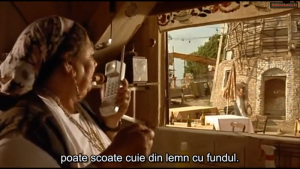
O Kusturica kamel te sikavel sode de palpalde si le rom.
„Von si primitivea, numa silen telefoanea mobile“,
phenel vo ando intervio ando „The Guardian“ 1999.
Kana avelas pala´o Kusturica, trubujas amen le rom, te avas maj jek shel bersh d´akanara inkea, phandade katar orsavi tehnologia, te trajisaras ande sumnakuni cushka. Le manush kaj dikhen leske filme, dashtinas sar ka´o Zoo, te asan amare trajostar thaj amarea dukhatar, sar vi kav chirko. Jek anti-tsiganistiko klasiko, kaj ushuril le manushenge, te thon le romen ande jek piri, katar te ankalavellen orikana trubujlen.
Aver artikole pala Emir Kusturica:
Kotor 1: O Emir Kusturica thaj leska „Gipsys“ –> Kotor 1 Audio Version
Kotor 2: Perspektiva pala „Time oft he Gipsys“ (1989) –> Kotor 2 Audio Version
Akana dikhen: Kotor 3: Perspektiva pala „Black cat, white cat“ (1998) –> Kotor 3 Audio Version
Kotor 4: Perspektiva pala „Blue Gipsy – All the invisible children“ (2005) –> Kotor 4 Audio Version
auke shaj ashunen sa ande jekh Audio Version Kotor 1-4
]]>